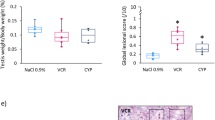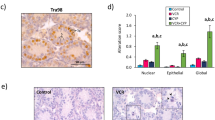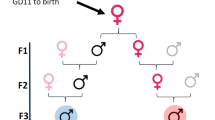Abstract
The use of cytotoxic, mutagenic and carcinogenic agents as treatment for various types of cancer may be particularly hazardous in men of reproductive age as there exists the possibility that this may lead to congenital malformations in the progeny. Such agents can affect fertility and other aspects of male reproductive function, for example, treatment with anti-cancer drugs such as cyclophosphamide has been associated with oligozoospermia, azoospermia and increased levels of serum follicle-stimulating hormone (FSH)1,2. Depending on the cumulative dose and the duration of treatment, spermatogenesis often returns but this may take years3,4. The relevance of the effects of such chemicals on the male reproductive system to the offspring is poorly understood. We have set out to determine whether present tests of male reproductive function (that is, endocrine status, numbers of spermatozoa, fertility) can predict deleterious effects of a paternally administered agent on the offspring. Here, we report that chronic administration in ratsof low doses of the widely used drug cyclophosphamide had minimal effects on the male reproductive system and fertility, but resulted in malformations and retardation of growth in the surviving fetuses and a high frequency of fetal death. Thus, adverse effects on the fetus cannot be predicted from the effects of a drug on the male reproductive system.
This is a preview of subscription content, access via your institution
Access options
Subscribe to this journal
Receive 51 print issues and online access
$199.00 per year
only $3.90 per issue
Buy this article
- Purchase on Springer Link
- Instant access to full article PDF
Prices may be subject to local taxes which are calculated during checkout
Similar content being viewed by others
References
Schilsky, R. L., Lewis, B. J., Sherins, R. J. & Young, R. C. Ann. intern. Med. 93(1), 109–114 (1980).
Chapman, R. M., Rees, L. H., Sutcliffe, S. B., Edwards, C. R. W. & Malpas, J. S. Lancet i, 285–289 (1979).
Buchanan, J. D., Fairley, K. F. & Barrie, J. U. Lancet ii, 156–157 (1975).
Roeser, H. P., Stochs, A. E. & Smith, A. J. Aust. NZ J. Med. 8, 250–254 (1978).
Livingston, R. B. & Carter, S. K. Single Agents in Cancer Chemotherapy, 25–80 (IFI/Plenum, New York, 1970).
Clermont, Y. & Harvey, S. C. Endocrinology 76, 80–89 (1965).
Clermont, Y. Physiol. Rev. 52(1), 198–236 (1972).
Hales, B. F., Smith, S. & Robaire, B. Teratology 27(2), 47A (1983).
Amann, R. P. J. Androl. 2, 37–58 (1981).
Zar, J. H. Biostatistical Analysis, 291–295 (Prentice-Hall, Englewood Cliffs, 1974).
Graul, E. H., Schaumloffel, E., Hundeshagen, H., Wilmanns, H. & Simon, G. Cancer 20(5), 896–899 (1967).
Bagley, C. M., Bostick, F. W. & DeVita, V. T. Cancer Res. 33, 226–233 (1973).
Botta, J. A. Jr, Hawkins, H. C. & Weikel, J. H. Jr Tox. appl Pharmac. 27, 602–611 (1974).
Adams, P. M., Fabricant, J. D. & Legator, M. S. Science 211(2), 80–82 (1980).
Moreland, F. M., Sheu, C. W., Springer, J. A. & Green, S. Mutat. Res. 90(2), 193–199 (1981).
Allen, J. W. & Latt, S. A. Chromosoma 58, 325–340 (1976).
Goetz, P., Malashenko, A. M. & Surkova, N. Folia biol., Praha 26, 289–297 (1980).
Brawer, J., Schipper, H. & Robaire, B. Endocrinology 112(1), 194–199 (1983).
Scheer, H. & Robaire, B. Endocrinology 107(4), 948–953 (1980).
Robb, G. W., Amann, R. P. & Killian, G. J. J. Reprod. Fert. 54, 103–107 (1978).
Dunnet, C. W. in Statistics in Endocrinology (eds McArthur, J. W. & Colton, T.) 79–103 (MIT Press, Cambridge, 1967).
Author information
Authors and Affiliations
Rights and permissions
About this article
Cite this article
Trasler, J., Hales, B. & Robaire, B. Paternal cyclophosphamide treatment of rats causes fetal loss and malformations without affecting male fertility. Nature 316, 144–146 (1985). https://doi.org/10.1038/316144a0
Received:
Accepted:
Issue Date:
DOI: https://doi.org/10.1038/316144a0
This article is cited by
-
In vivo enrichment of busulfan-resistant germ cells for efficient production of transgenic avian models
Scientific Reports (2021)
-
Genes associated with survival of female bovine blastocysts produced in vivo
Cell and Tissue Research (2020)
-
Parental exposure to methyl methane sulfonate of three-spined stickleback: contribution of DNA damage in male and female germ cells to further development impairment in progeny
Ecotoxicology (2013)
Comments
By submitting a comment you agree to abide by our Terms and Community Guidelines. If you find something abusive or that does not comply with our terms or guidelines please flag it as inappropriate.



